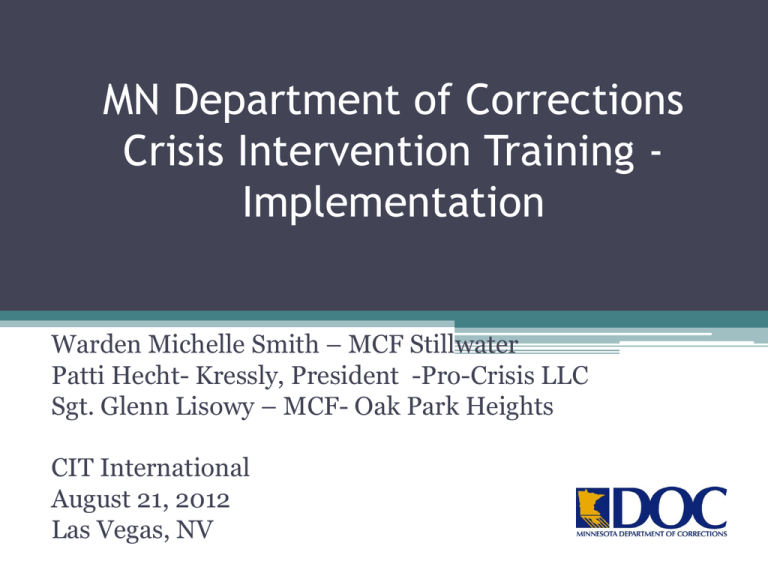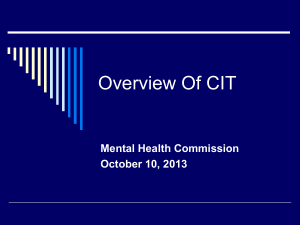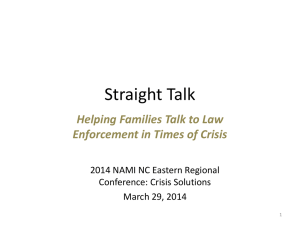challenges and benefits of implementing cit
advertisement

MN Department of Corrections Crisis Intervention Training Implementation Warden Michelle Smith – MCF Stillwater Patti Hecht- Kressly, President -Pro-Crisis LLC Sgt. Glenn Lisowy – MCF- Oak Park Heights CIT International August 21, 2012 Las Vegas, NV CIT video Correctional Facilities in Minnesota MCF-Stillwater (1635) MCF-Oak Park Heights (473 ) MCF-Rush City (1030) MCF-St. Cloud (1054 ) Crisis Intervention Training (CIT) Implementation • Do it right ▫ 40 hours ▫ Excellent Speakers ▫ Focus on Role Plays Enough time As Real As Possible (ARAP) Scenarios Actors Coaches Class size • Our goals for the training ▫ New skills ▫ Attitudes ▫ Culture Change • Who should attend ▫ Application process Selection Selection Selection (Recruitment) CIT Steering Committee Deputy Commissioner Director Behavioral Health National Alliance on Mental Illness (NAMI) Training Committee (Warden Rep) Research Director Director of Employee Development Facility CIT Representatives (one each) CIT Training Committee Facility CIT Committees Warden NAMI Employee Development Behavioral Health CIT “Expert” Security Representative Contractor Associate Warden Operations Mental Health Director NAMI/Advocate Additional members NAMI Support • Panelists/speakers • Unique perspective • Reaching out to community partners to strengthen CIT infrastructure Selection of officers • Long-range Goal is to train 20% of DOC Security Staff. To start at OPH, STW, RC & SCL. • Not every officer is cut out to be a CIT officer nor do they have an interest. • Our selection process identifies those officers with good people skills, patience, and an ability to think critically. No discipline record. • Beginning with Officers working in Segregation and with our growing Mental Health offender population. Working toward all officers and other staff within the facilities. CIT Course Topics • Day One ▫ ▫ ▫ ▫ Introduction and Overview – warden History of CIT – warden Mental Health Basics – Ph.D. from facility Round Table – NAMI MN facilitator and consumers ▫ De-escalation and communication techniques ▫ Role Play • Day Two ▫ Axis 2 Mental health – Personality Disorders Therapist from Mental health Facility ▫ ▫ ▫ ▫ Medications Suicide risk factors and prevention Self Care Role Play • Day Three ▫ ▫ ▫ ▫ Treatment Systems Overview of special need offenders – TBI DD Ex- Offender experience Experiential Exercises- hearing voices mp3 and other exercises. ▫ Role Play • Day Four ▫ Site Visits Recovery Program/half way house MN DOC mental health facility Out patient/day treatment ▫ Civil Commitment ▫ Cultural Competency ▫ Military Vets and PTSD • Day Five ▫ ▫ ▫ ▫ Role Play Policy and Procedure CIT Resources Graduation Wardens from all facilities with students Commissioner of Corrections Other dignitaries Role Plays for DOC CIT • MN DOC Officers participate in 8 hours of Role Playing within the 40 hour class. • Professional Actors as role players ▫ Actors must fit demographics of offenders. ▫ Actors “experienced” inside two of the facilities. • Scenarios must be realistic to officers experiences. ▫ Terms, locations, weapons, clothing, safety. ▫ Crisis situations Compare/Contrast CIT: Law Enforcement vs. Corrections • Beliefs of CIT (Hug a thug) and changing the culture of the system. • Contact time with Offender. • Officer Safety and Security Issues. • Policy and procedure differences. • Availability of resources. CIT Officer Perspective Sgt. Glenn Lisowy • • • • Need for it Already do it (IPC) Training is a reference point Support of Administration Recognition of CIT officers • Recognizing CIT officers provides an incentive for them to continue with CIT. • Let staff know there participation is important and helps provide a sense of accomplishment and ownership to this program. Program Evaluation and Sustainability • Evaluation can help measure the impact of the CIT program (outcomes), can help with program improvements and provide the kind of information to assist with sustainability. • There needs to be a system in place for on-going training to ensure your knowledge and skills remain sharp. Minnesota Department of Corrections Progress • Sent 4 teams to NIC training: Central Office 12/10, Stillwater 3/11, Oak Park Heights 7/11, Rush City 12/11 Crisis Intervention Teams: A Frontline Response to Mental Illness in Corrections • Hired contractor to assist with CIT training • Completed 40 hour training curriculum • Provided (3) trainings (Nov 2011, Feb 2012, May 2012 ) 86 Department of Corrections staff, 5 Hennepin County Staff and 2 Iowa Depart of Corrections staff. Minnesota Department of Corrections Progress – Continued • Provided coaches training – 17 Department of Corrections staff • Completed CIT policy • Completed CIT incident report form • Planning to involve Shakopee, Red Wing • Hoping to continue partnerships with other local agencies as well as other States. CIT Policy Elements • • • • • • • • Purpose and Definitions Application & selection process Training program outline and essential components Ongoing refresher training Available officers CIT activation and appropriate utilization Report & evaluation Officer removal from CIT • Copies available on request Five Year Plan Framework • CIT should be well-integrated into DOC facilities ▫ A minimum of 25% of correctional officers are CIT trained ▫ We should have a solid core of coaches at each site ▫ CIT symposium and recognition program will be well attended • Evaluations of CIT should show that it is effective ▫ Improves safety for staff and offenders ▫ Decreases instances of use of force • Minnesota DOC will be recognized nationally for integrating CIT into facilities and field services DOC CIT class #1 November 4, 2011 DOC CIT class #2 February 10, 2012 DOC CIT class #3 May 14-18, 2012 Questions??? Thank You and Good Luck! Michelle Smith - Warden MCF-Stillwater Michelle.smith@state.mn.us Patti Kressly - President Pro-Crisis patti@procrisis.com Glenn Lisowy- Sergeant MCF-Oak Park Heights











